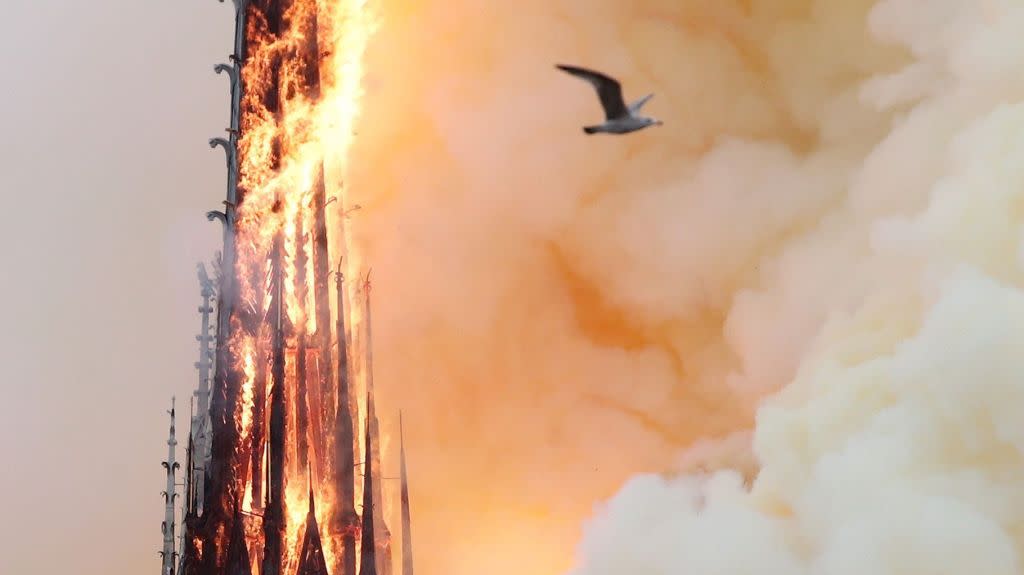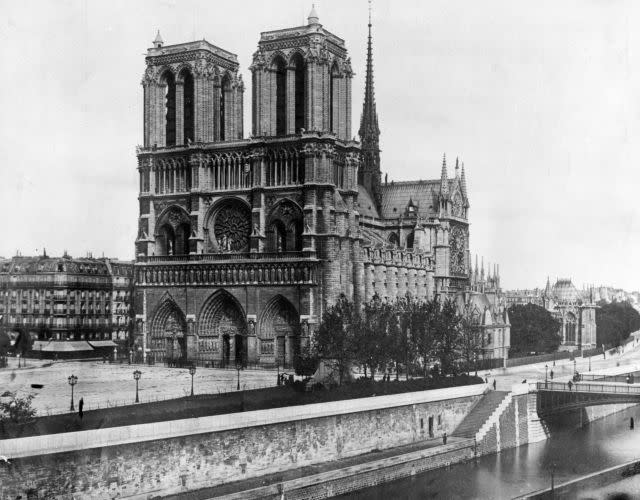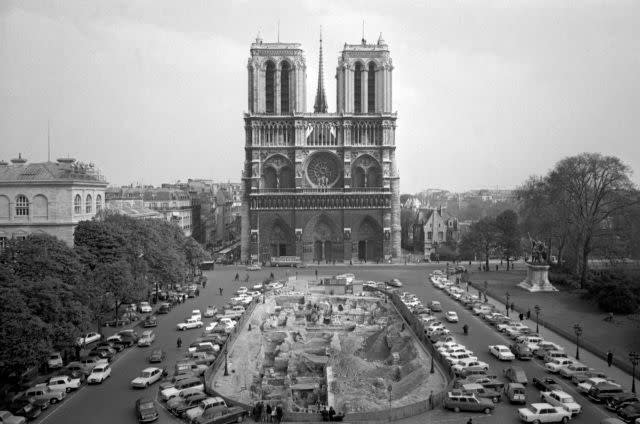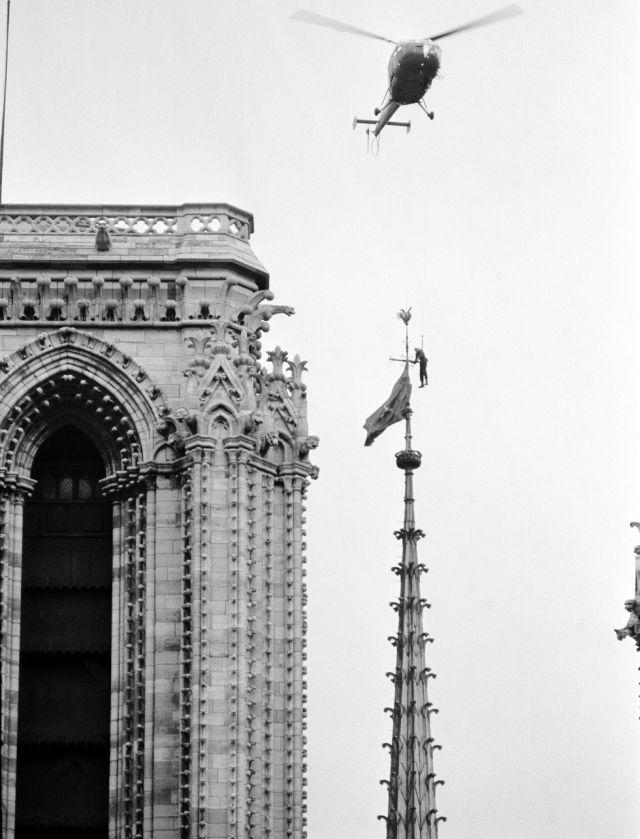Should Notre Dame’s beloved spire be rebuilt?

Parisians are mourning the loss of Notre Dame’s iconic spire, the most prominent casualty of the fire that ravaged the 800-year-old cathedral.
For many of the city’s current dwellers, la flèche (the arrow) was as indispensable to Notre Dame’s silhouette as its portly bell towers. But the fallen 305-foot structure didn’t have the same Gothic pedigree. It was added in the 1850s during a restoration led by French architect Eugène Emmanuel Viollet-le-Duc. His inspiration: the 19th- century cathedral of Orleans.
Today, prime minister Édouard Philippe said there will be an international competition (link in French) to determine the spire’s fate, part of Emmanuel Macron’s promise to get the cathedral back up in five years. The contest is meant to settle the question of whether to build a spire at all, and if yes, whether it should be Viollet-le-Duc’s, or a “new flèche, adapted to the techniques and challenges of our time,” he said.
History shows it won’t be an easy question to answer—and that there will surely be a fight about it.
What is restoration?
This is a debate Parisians have been having for at least 200 years or so, since Victor Hugo and others started advocating for the preservation of Notre Dame.
Nearly 700 years after its first stone was laid, the cathedral was in a sorry state. In 1548, the Protestant Huguenots had vandalized the building, and some 250 years later, French revolutionaries decapitated its stone kings. During that period, the stately cathedral was used for storage, its bells melted to make cannons. Its first spire disappeared sometime between 1786 and 1792.
Up to the early 19th century, the cathedral’s Gothic style had been considered somewhat barbaric. Under the romantic lens of the time, Hugo and others rebranded it as a symbol of liberation from dogma and stiff hierarchies. Hugo’s Notre-Dame de Paris, first published in 1831, was a powerful piece of marketing. His ode to the cathedral, the era’s equivalent of a New York Times bestseller, spurred a preservation wave. Viollet-le-Duc rode it, getting a commission to restore Notre-Dame in 1844.
Both men wanted to save France’s medieval treasures. They didn’t necessarily agree on the definition of restoration. Hugo fell into what has been called the anti-restoration camp, which saw historic buildings as evolving structures and found beauty in the resulting pastiche, as conservator Jukka Jokilehto explains in his history of architectural restoration.
“This generative Mother-Church is, among the other ancient churches of Paris, a sort of Chimera: she has the head of one, the limbs of another, the body of a third—something of all,” Hugo wrote in the novel itself.
In an angry pamphlet titled War against the demolishers, he begged restoring architects to be “frugal with their own imaginations.”
Villet-le-Duc leaned more toward returning monuments to their original concept, creating “frozen illustrations” of historic periods, in Jokilehto’s words.
“The word and the thing itself are modern,” wrote Viollet-le-Duc referring to restoration. “To restore a building is not to maintain it, repair it, or rebuild it; it is to re-establish it in a complete state that might never have existed at any given moment.”

Notre Dame in 1911, less than century after Viollet-le-Duc added the spire.
In other words, he saw restoration more as a remodel. At Notre Dame that meant taking some liberties, including the new, bigger spire. His restoration plan for the cathedral was challenged from the start.
“Who is able to say what was there? Who would dare to replace a Gothic idea, the creation of the Middle Ages, by his own idea, his own creation?” wrote a prominent archeologist in response to some of Viollet-le-Duc’s proposals.
Restoration standards
The criteria of how to preserve historic monuments has evolved since the restoration wars of the 19th century. The most widely accepted global standards are part of the 1964 Charter of Venice, in which the international community adopted a more Hugo-like approach. Here’s what it says about restoration:
Its aim is to preserve and reveal the aesthetic and historic value of the monument and is based on respect for original material and authentic documents. It must stop at the point where conjecture begins, and in this case moreover any extra work which is indispensable must be distinct from the architectural composition and must bear a contemporary stamp.
And on replacing lost elements:
Replacements of missing parts must integrate harmoniously with the whole, but at the same time must be distinguishable from the original so that restoration does not falsify the artistic or historic evidence.
Under those standards, Viollet-le-Duc’s spire would have been a no-no.

By the 1960s, Violllet-le-Duc’s rebuilding of the spire would have been unthinkable. Here it is in 1967.
Still, the Venice charter didn’t settle the issue of what exactly is authentic and worth preserving. Or what, if anything, are the stewards of historic buildings to do with non-authentic elements, or whether there are any circumstances that warrant reconstructing them.
Look no further than Notre Dame to see the predicaments that can arise from lack of clarity on those questions. In 2011, a brouhaha erupted over the church’s plan to replace its bells. The goal was to recreate their 17th century sound. For some Parisians, that was too much meddling with history, even though the bells were low-quality casts added in the 19th century, many hundreds of years after the cathedral was built. Had the bells been original, historic accuracy would have been preserved for the eye but not the ear: The bells would have fallen out of tune through age. (Bells, like light bulbs, don’t last forever.)
The entire cathedral is full of later additions like the bells, including part of the wooden structure that burned during this week’s fire, and some of the cathedral’s famous gargoyoles, or chimères.
A vindication for Viollet-le-Duc?
In recent years, the gatekeepers of restoration propriety have been loosening up standards. UNESCO, the official curator of what’s worth preserving in the world, has been sanctioning more rebuilds. Its change of heart is tied to the destruction of architectural treasures due to war and cultural intolerance. It could also be applied to Notre Dame, itself part of a UNESCO world heritage site. For now, the agency is vowing to help with the rebuilding.
These images are so sad & painful to watch…
Now, @UNESCO stands ready to:
Make available our expertise to the authorities
Contribute to a rapid damage assessment
Support the reconstruction & rehabilitation of #NotreDame
https://t.co/KrDjfKWRsD#WorldHeritagepic.twitter.com/Zado75k7TR
— UNESCO (@UNESCO) April 16, 2019
The reputation of Viollet-le-Duc, once called a “criminal of history” and accused of inflicting more damage on Notre Dame than the Huguenots and the Revolutionnaires, has also been restored. By 2014, curators of a retrospective exhibit of his work at Paris’s Cité de Architecture et Patromonie referred to him as “a great visionary.”
“Viollet-le-Duc can continue to look towards the flèche of Notre-Dame without worry—because no one is going to remove it,” read a review of the exhibit in Le Journal de Dimanche at the time. Its title: Viollet-le-Duc, “a barbarian” at last recognized.

The spire was part of Paris’s contemporary history. In 1969, the flag of the Viet Cong was unfurled from it as a protest against support for the US war in Vietnam. A firefighter dangling from a helicopter removed it.
By the time it burned, his spire had arguably become yet another layer in the virtual Notre Dame mille-feuille built atop a temple dedicated to Jupiter—part of the cathedral’s historic evolution that Victor Hugo so admired.
Does that mean the flèche should be rebuilt?
“What needs to happen now is a new debate around monumental restorations and the criteria that need to be followed to bring back an image that is the emblem of Paris,” says Daniel Ortiz Pradas, a professor at Madrid’s Complutense University who has studied 19th century restoration.
Sign up for the Quartz Daily Brief, our free daily newsletter with the world’s most important and interesting news.
More stories from Quartz:

